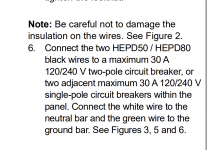My friend, thank you for attempting to help. I am a licensed electrician as everyone on this site should be. Type 1 SPDs are designed to be installed on the line side of the service disconnect in my case this would be a main breaker. But that is not usually practical and the instructions for this particular unit do not show putting it on the line side. They instead show putting it on the load side but still directly connected to the bus via the posts that the main breaker connects to. My question was never whether or not it could be connected directly to the bus as it’s a fact that it can and I have attached the instruction manual for you guys to look at page 4 through 6 to see what I am talking about. My question was about installing connectors on the wires so they could be detached without having to shut the main breaker off. Is there anyone out there that knows what I am asking? Where is Larry Fine

️?
Hey,Doc13067, et al.
Now that I have seen the image of the installation I have a much better feeling about what was originally posted.
Actually you're not really drilling and tapping out a threaded hole for a threaded machine screw to make it adaptable directly to the bus bars.
That was my understanding when I read the original post. Hence my serious warning about drilling into the bus bars.
The mfg's installation instructions seems to make it clear to
mount it as shown in the images.
I think the OP said the device(SPD) was loosely left dangling without support as required as shown in the installations.
That is a violation of the installation instructions as per mfg. The mfg shows it to be mounted via the threaded nipple with a lock-nut.
Can the panel cover be replaced without damage to the SPD?
Also, are the crimp-on terminals factory installed?
And, it looks like the SPD is on the load side of the 200 A CB so you can turn it off and safely replace the SPD if ever needed ?
If not, it too is a violation of NEC and NFPA 70E.
Now, I think we all can breath a sigh of relief knowing that he is not drilling into the energized bus bars.
Thanks to the OP for the installations image.
I don't know where Larry Fine is. He'll surface.
Forever posting
Always reading something electrical
Thanks,
TX+MASTER#4544



